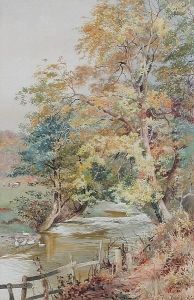Thomas Bushby Paintings
Thomas Bushby was an English painter known primarily for his watercolor works and his role as an art teacher. Born in 1861 in London, England, Bushby was part of the late Victorian and Edwardian art scenes, which were characterized by a variety of styles and subject matters, ranging from the traditional to the more experimental.
Bushby's artistic career is noted for its focus on landscapes and rural scenes. His work often depicted the English countryside with a delicate and meticulous approach, capturing the changing seasons and the play of light with a gentle realism that was appreciated in his time. His style was consistent with the British watercolor tradition, which emphasized transparency and fluidity, showcasing Bushby's skill in handling the medium.
In addition to his painting, Bushby was also dedicated to art education. He taught at various institutions, sharing his knowledge and techniques with aspiring artists. His influence as a teacher extended to his students who would carry forward his artistic values and approach to watercolor painting.
Despite his talents, Thomas Bushby did not achieve the same level of fame as some of his contemporaries. His work, however, has been exhibited in various galleries and has been appreciated by collectors and art enthusiasts for its charm and technical proficiency.
Thomas Bushby's life was cut short by the 1918 influenza pandemic, which claimed the lives of millions worldwide. He passed away at the age of 57, leaving behind a modest but respected body of work that continues to be of interest to those who study British watercolorists of the late 19th and early 20th centuries. His contribution to the arts, particularly in the realm of teaching, also remains a significant part of his legacy.



